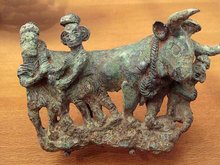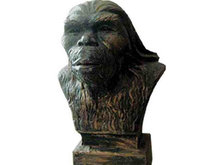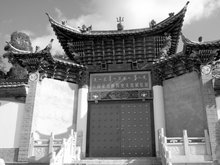
The Yuanmou Man, a Homo erectus fossil unearthed by railway engineers in the 1960s, has been determined to be the oldest known hominid fossil in China. By the Neolithic period, there were human settlements in the area of Dianchi Lake. These people used stone tools and constructed simple wooden structures.
 |
 |
 |
Bronze sculpture of the Dian Kingdom, 3rd century BCE / Yuanmou Man / Mongolian Gate in Yunnan
Around the 3rd century BC, the central area of Yunnan around present day Kunming was known as Dian. The Chu general Zhuang Qiao entered the region from the upper Yangtze River and set himself up as "King of Dian". He and his followers brought into Yunnan an influx of Chinese influence, the start of a long history of migration and cultural expansion.
In 221 BC, Qin Shi Huang unified China and extended his authority south. Commanderies and counties were established in Yunnan. An existing road in Sichuan – the "Five Foot Way" – was extended south to around present day Qujing, in eastern Yunnan. In 109 BC, Emperor Wu sent General Guo Chang south to Yunnan, establishing Yizhou commandery and 24 subordinate counties. The commandery seat was at Dianchi county. Another county was called "Yunnan", probably the first use of the name. To expand the burgeoning trade with Burma and India, Emperor Wu also sent Tang Meng to maintain and expand the Five Foot Way, renaming it "Southwest Barbarian Way". By this time, agricultural technology in Yunnan had improved markedly. The local people used bronze tools, plows and kept a variety of livestock, including cattle, horses, sheep, goats, pigs and dogs. Anthropologists have determined that these people were related to the people now known as the Tai. They lived in tribal congregations, sometimes led by exiled Chinese.
During the Three Kingdoms, the territory of present day Yunnan, western Guizhou and southern Sichuan was collectively called Nanzhong. The dissolution of Chinese central authority led to increased autonomy for Yunnan and more power for the local tribal structures. In AD 225, the famed statesman Zhuge Liang led three columns into Yunnan to pacify the tribes. His seven captures of Meng Huo, a local magnate, is much celebrated in Chinese folklore.
In the 4th century, northern China was largely overrun by nomadic tribes from the north. In the 320s, the Cuan clan migrated into Yunnan. Cuan Chen named himself king and held authority from Lake Dian (then called Kunchuan. Henceforth the Cuan clan ruled Yunnan for over four hundred years. In 738, the kingdom of Nanzhao was established in Yunnan by Piluoge, who was confirmed by the imperial court of the Tang Dynasty as king of Yunnan. Ruling from Dali, the thirteen kings of Nanzhao ruled over more than two centuries and played a part in the dynamic relationship between China and Tibet. In 937, Duan Siping overthrew the Nanzhao and established the Kingdom of Dali. The kingdom was conquered by the Mongol Empire in 1253. During the Yuan Dynasty Kublai Khan appointed the first governor, Turkmen Sayid Ajall, in Yunnan in 1273. Before that, the area had been ruled by a local king and a Mongol prince under the Great Khan. Yunnan and Hunan were main bases for Mongol military operations in Indo-China. The Ming Dynasty destroyed the Yuan loyalists in 1381 in the Ming conquest of Yunnan.
In 1894, George Ernest Morrison, an Australian correspondent for The Times, travelled from Beijing to British-occupied Burma via Yunnan. His book, An Australian in China, details his experiences.
Yunnan was transformed enormously by the events of the war against Japan, which caused many east coast refugees and industrial establishments to relocate to the province. It assumed great strategic significance, particularly as the Burma Road was constructed from Kunming to Lashio in Burma during this time. (wikipedia)
- 862 reads
